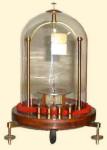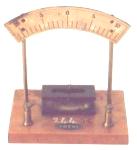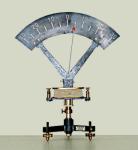Description
Upon a solid base with adjustable screws the magnet is fixed with polar expansions. The
mobile coil, very solid and without a damper, is suspended with a bronze ribbon, fixed at the
upper end to a suspension adjustable in the vertical direction and turning on a horizontal
plane. At the bottom end the ribbon is fixed to a spring adjustable with a set screw. The
mirror of D’Arsonval’s galvanometer is replaced with a mobile index of aluminium in front of
the scale, visible from afar.
The tension of the ribbon is regulated so that, applying a thermoelectric couple made
of copper wire and a nickel silver wire allows to the binding posts, we obtain visible
indications when we warm slightly the junction of the two wires.
By applying a normal telephone receiver to the binding posts, we get clearly visible
shifts of the index for little collisions on the vibrating lame.
|


 Menu
Menu












